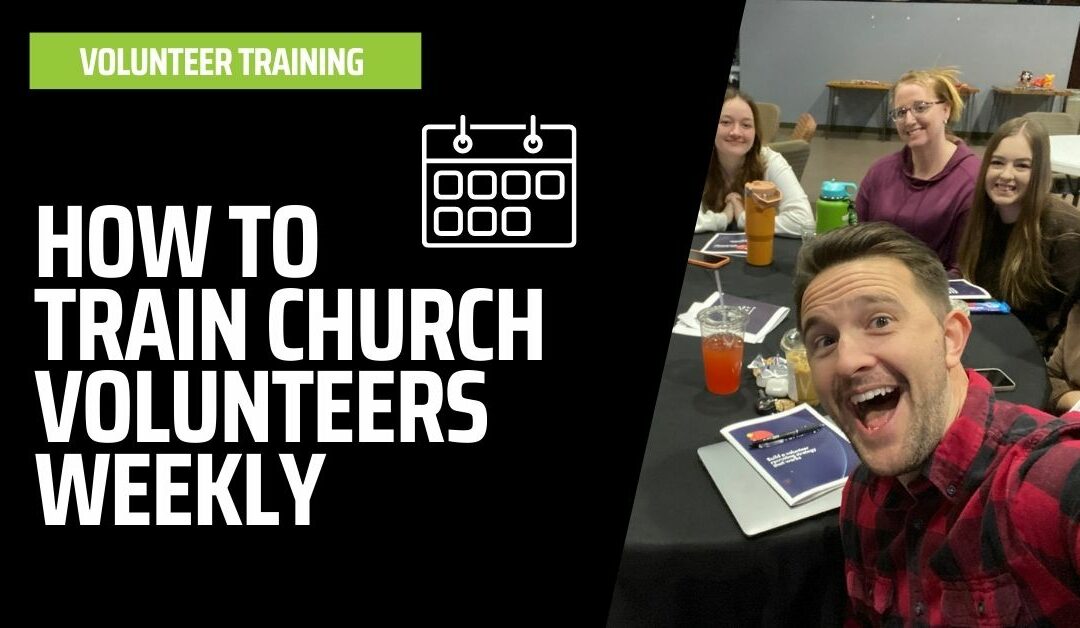When it comes to leading volunteers, one of the biggest opportunities we can miss is the chance to train them regularly. Many of us might think about volunteer training as something that happens once or twice a year, perhaps reminiscent of how we were trained in our own experiences. While those occasional big events are beneficial, effective training should extend beyond that and occur much more frequently—ideally, on a weekly basis.
Weekly volunteer training doesn't have to be a daunting task. Consider implementing volunteer huddles, short gatherings held before service times, as part of your strategy. A huddle, much like a quick meeting in sports, should be concise yet effective. For example, we can plan these sessions in a way that fits into a 10 to 15-minute window, making the most of every minute to provide valuable, bite-sized training. A well-structured huddle not only trains but also fosters a sense of community and keeps everyone aligned. Let's dive into how we can make weekly training a transformative part of our volunteer program.
Key Takeaways
- Regular volunteer training should occur weekly.
- Volunteer huddles are an effective format for weekly training.
- Planning content in advance helps maintain consistency and focus.
Recognizing the Significance of Consistent Volunteer Training
We often overlook the chance to enhance our volunteer leadership by ensuring regular training. Many of us consider volunteer training to be a once or twice-a-year event. Reflecting on my own experience as a church volunteer, I remember such training sessions being infrequent.
Instead of treating training as an occasional event, let's commit to making it an ongoing practice. Ideally, we should aim to train volunteers weekly.
To achieve this, we can organize volunteer huddles. These are brief gatherings before volunteers begin their service. For example, in our church’s kids ministry, we meet 30 minutes before the service at 9 A.M. We spend about 10-15 minutes in the huddle. Here's a typical schedule:
| Time | Activity |
|---|---|
| 8:30 – 8:40 | Volunteer huddle |
| 8:40 – 8:45 | Quick training session |
| 8:45 – 9:00 | Final preparations |
| 9:00 | Service begins |
We can share short lessons or insights during these huddles, taking 3-5 minutes for training.
Planning is crucial for effective training. We should map out our training content for the next three to six months. A simple approach involves using a book or article, breaking it into small portions, and discussing these each week. Creating a guide or summary sheet for each huddle ensures consistency.
Moreover, holding volunteers accountable is key. If someone misses a huddle, we should follow up, ensuring everyone understands its importance. Regular training isn't just an extra; it's part of our volunteers' roles.
To assist in this process, resources like the MinistryBoost.org huddle course and archive can be invaluable. These tools offer ready-made content to jump-start our training efforts.
By integrating these practices, we can maintain a structured and ongoing volunteer training program.
Weekly Training Implementation
Setting Up Volunteer Gatherings
One of the most effective methods for consistent volunteer training is through short, focused gatherings. Think of these sessions as “huddles” where we spend about 10-15 minutes before service. Let's consider starting at least 30 minutes early, allowing a short meeting before any major activities begin. Each gathering should include about 3-5 minutes dedicated to training.
Establishing Regular Training Sessions
To maintain a steady flow of training, creating a structured plan is essential. We should look at our calendar and plan out the next three to six months of training topics. Consider breaking down a book into manageable sections or utilizing video content. Ensuring the content is bite-sized will make it easier to integrate into weekly routines. Utilize a training guide or handout, especially if multiple people will be leading these sessions.
Organizing Your Training Content
Crafting a Three to Six-Month Training Plan
Creating a comprehensive plan for training volunteers over a span of three to six months is essential. Start by examining your calendar and determining the optimal times for your volunteer huddles. These huddles should occur before volunteers start their roles, allowing them to gather for a brief 10 to 15-minute session.
When planning, remember to keep the training materials concise and manageable. Incorporate content from a book, breaking it down into small, digestible sections that can extend over several weeks. This method ensures that training is impactful without being overwhelming.
A practical approach could be to repeat training topics over two weeks to accommodate volunteers who serve less frequently. For instance, you might cover the same subject during the first two weeks, moving to a new topic for the latter part of the month. This way, everyone receives consistent training despite varying schedules.
Selecting Concise Learning Resources
When it comes to the materials for your volunteer huddles, choosing bite-sized content is crucial. Look for resources like succinct book excerpts or short videos that can easily fit into a 3 to 5-minute training slot. You could even implement a model where the huddle leader reads a small section of a book, facilitating a quick discussion afterward.
For multimedia content, ensure it’s brief but informative. A six-minute video watched together and discussed can be very effective. Alternatively, assign the video as homework, then dedicate a few minutes each week to discussing its content over the month.
It’s also beneficial to create huddle guides or question sheets to aid discussion. These resources can streamline the training process, especially when empowering others to lead the huddles. Keeping track of attendance and encouraging regular participation will help maintain consistency and accountability within the team.
Crafting a Successful Huddle Format
Optimal Times and Setup for Volunteer Gatherings
To encourage consistent volunteer training, we recommend holding regular huddles. These short gatherings should be no more than 15 minutes long, scheduled just ahead of when your volunteers are set to serve. For example, if a service starts at 9 a.m., a huddle at 8:30 a.m. gives a quick 10-15 minute window before duties need to commence.
It's helpful to vary the length of your huddles based on the type of service. In children's ministry, a quick 10-minute huddle may work best, while student ministries might benefit from slightly longer sessions, up to 20 minutes. The aim is to make these huddles engaging yet concise, similar to a football huddle but without the rush, ideally keeping it around 10-15 minutes.
Using three to five minutes of the huddle for training can ensure that educational elements are included without dominating the session. By planning out your training content in three to six-month chunks, you can create a streamlined and consistent approach. This could mean covering two topics a month if your volunteers serve bi-weekly, ensuring everyone stays on the same page.
Integrating Educational Content into Gatherings
Weekly volunteer training doesn't have to be daunting or time-consuming. By leveraging books, videos, or articles broken down into bite-sized portions, you can make training sessions manageable and impactful. The leader might read a page from a book, discuss a brief video, or go over an article in segments. This approach helps spread out content and reduces preparation time.
Creating a huddle guide or a reference sheet can provide structure for these sessions, outlining discussion questions or key points to cover. This guide can be shared with anyone leading the huddle, ensuring consistency across all gatherings.
Accountability is crucial. If someone misses a huddle, make a note and follow-up sensitively to understand why. Frequent absences could trigger a more serious conversation about their role and commitments. Keeping track of attendance reinforces the importance of these huddles as a vital part of the volunteer experience.
By setting up a structured yet flexible format, we can maintain regular and effective training for our volunteers, ensuring they are well-prepared and motivated each time they serve.
Resource Management for Volunteer Training
Utilizing Books and Manuals
We can use books and manuals effectively for volunteer training. Transforming a comprehensive book into small pieces allows us to cover essential topics without overwhelming anyone. Weekly huddles, for instance, can be enriched by reading a page or section from a book during each session. Volunteers don't need to do homework; they just engage with small, digestible bits of content. A leader can guide the discussion, ensuring everyone is on the same page. Using guides and manuals tailored to our training topics is cost-effective and easy to manage.
Making Use of Videos and Articles
Videos and articles are versatile resources for our volunteer training. We might choose a brief six-minute video to watch together and discuss. Alternatively, volunteers can view the video at home, and then we delve into discussions during the huddle. Articles work similarly; short enough articles can be read on the spot, or longer ones can be broken down over multiple weeks. This method keeps everyone focused and engaged without adding extra work outside the huddle. Creating discussion guides based on these materials can help leaders facilitate conversations and ensure productive training sessions. Our goal is to integrate these resources smoothly into our regular interactions with volunteers.
Crafting Volunteer Gathering Guides
Developing Thought-Provoking Questions
When we plan our volunteer gatherings, one key element is the discussion questions. These questions drive engagement and learning. We can pull questions directly from a book or video we're using. Breaking the content into small sections and focusing on a few key points each week ensures the discussions are meaningful.
Having a set of pre-prepared questions also helps our leaders feel more equipped. We might prepare a simple handout or a digital document that leaders can refer to during these huddles. This makes it easier to guide the conversation and keeps everyone on track.
Sharing Leadership Resources
We should provide our leaders with materials that help them succeed in their roles. This can include excerpts from relevant books, short training videos, or articles. The goal is to give them something they can easily incorporate into the huddle without needing extensive preparation.
Another helpful strategy is using a consistent resource, like a book, over a period of time. If we break the book into digestible parts, like one chapter or section per week, we can create a steady flow of training content. This method also reduces the burden on our leaders to constantly come up with new material.
In providing these resources, we make sure they support the leaders' efforts to foster meaningful discussions and continuous growth among our volunteers.
Responsibility and Participation
Keeping Track of Attendance
We need to be proactive with our tracking methods to ensure everyone participates consistently. Having a system in place to monitor attendance helps us recognize any patterns of absenteeism early on. Using simple tools like attendance sheets or digital check-ins can be effective.
Checking In with Missing Volunteers
If a volunteer misses a session, we should reach out to them to see if everything is okay. Our rule is simple: if someone misses more than one session, we start asking questions. The goal is to support our volunteers, understand any issues they might be facing, and help them stay engaged. Regular check-ins show that we value their presence and commitment.
Extra Materials for Team Gatherings
Making the Most of Ministryboost.org
Ministryboost.org offers us a wealth of resources, including an entire course dedicated to setting up successful huddles. We can dive into this course to gather tips, strategies, and practical tools to ensure our volunteer huddles run smoothly and effectively.
Tapping into the Meeting Archive for Topics
The Huddle archive provides an extensive collection of content that spans over a year, perfect for us to use straight away. This archive features material organized from various books, giving us topics that we can discuss in our huddles. By leveraging these pre-made plans, we save time and effort in the early stages of planning.
Long-Term Training Strategies
One of the big opportunities we often miss when it comes to leading volunteers is training them regularly. We tend to think of volunteer training as an event that happens once or twice a year.
What if we could train our volunteers weekly instead? Imagine having volunteer huddles; a simple, brief gathering before they serve. Our church meets for about 10-15 minutes, giving us a chance to cover vital training points.
Here’s a weekly huddle idea: Plan out your training topics for the next three to six months. Break down a book into small pieces or find videos that can be reviewed over multiple weeks. We don’t need to create all this content ourselves; using existing resources can save time and effort.
To make the huddles effective, it’s useful to have a huddle guide. This can be a sheet with questions or key points for discussion. If we let others lead these huddles, especially in larger groups, we should empower them with this guide. Keeping track of attendance and encouraging regular participation also helps maintain engagement.
We also offer a course on launching huddles, along with a huddle archive from Ministry Boost. This archive includes over a year's worth of huddle content, making it easier to get started without planning everything from scratch.
Training volunteers doesn’t have to be overwhelming. Let's set up a structured, sustainable plan to keep our volunteers growing and equipped all year round.




